European Neighbourhood Policy - East - living conditions statistics
Data extracted in January 2023.
Planned article update: April 2024.
Highlights
Georgia’s inequality of income, as measured both by the income quintile share ratio and the Gini coefficient, declined considerably from 2011 to 2021 but was still greater than in the EU in 2021.
All the European Neighbourhood Policy countries for which data is available reported higher at-risk-of-poverty rates after social transfers than those observed for the EU in 2021 (Armenia data 2020).
Expenditure on social protection benefits in the EU in 2020 as a proportion of GDP was estimated to be three times that in Armenia (2020 data) and Georgia (2021 provisional data).
Proportion of the population at risk of poverty after transfers, 2011-2021
This article is part of an online publication and it presents information for five European Neighbourhood Policy-East (ENP-East) countries, namely, Armenia, Azerbaijan, Georgia, Moldova and Ukraine, compared with the European Union (EU). Georgia, Moldova and Ukraine also all became enlargement countries in 2022, the European Council giving the three a European perspective and granting Moldova and Ukraine candidate status on 23 June 2022. This article does not contain any data on Belarus, as statistical cooperation with Belarus has been suspended as of March 2022.
Data shown for Georgia exclude the regions of Abkhazia and South Ossetia over which Georgia does not exercise control. The data managed by the National Bureau of Statistics of the Republic of Moldova does not include data from Transnistria over which the government of the Republic of Moldova does not exercise control. Since 2014, data for Ukraine generally exclude the illegally annexed Autonomous Republic of Crimea and the City of Sevastopol and the territories which are not under control of the Ukrainian government. The latest statistics in this Statistics Explained article cover the calendar year 2021, before Russia’s invasion of Ukraine. Data on Ukraine for the year 2021 is limited due to exemption under the martial law from mandatory data submission to the State Statistics Service of Ukraine, effective as of 3 March 2022.
The article includes information relating to income distribution, the risk of poverty (before and after social transfers), as well as data relating to health and social protection expenditure. These statistics are used to observe living conditions and to formulate and monitor social policies.
Full article
Income distribution
The income quintile share ratio, also known as the S80/S20 ratio, is a measure of the inequality of the distribution of income. It is calculated as the ratio of the total income received by the 20 % of the population with the highest incomes (the top quintile) to that received by the 20 % of the population with the lowest incomes (the bottom quintile). Incomes are equivalised to take account of the varying composition of households.
Figure 1 shows that in 2021, Georgia, Moldova and Armenia (2020 data) reported more pronounced levels of inequality, based on the income quintile share ratio, than in the other two ENP-East countries and the EU. Ukraine and Azerbaijan reported a more equal income distribution than the EU. The lowest ratio was recorded in 2021 in Azerbaijan, where the income of the top quintile of the population was 2.8 times as high as the income of the bottom quintile. Between 2011 and 2021, the income quintile share ratio fell very strongly in Georgia and marginally in Armenia, while it remained stable in Ukraine. It increased in Azerbaijan and marginally in Moldova (where there was a break in the data series during this period, meaning that the values for these two years cannot be directly compared).
The income of the top population quintile in the EU was estimated at 5.0 times the size of the income of the bottom population quintile in 2021. This measure of income inequality in the EU is the same in 2021 as it was in 2011.
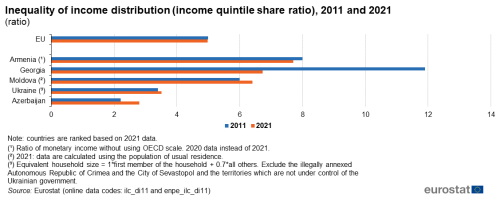
(ratio)
Source: Eurostat (ilc_di11) and (enpe_ilc_di11)
The Gini coefficient is an alternative measure of income inequality. It shows the extent to which all incomes within the population differ from the average income: the closer the Gini coefficient is to 100 the less equal are the incomes, while the closer it is to 0 the more equal are the incomes.
As shown in Figure 2, Georgia, Moldova and Armenia (2020 data) reported greater income inequality in 2021 than did the EU, measured by the Gini coefficient. Ukraine reported a lower Gini coefficient value, indicating greater income equality. This result is similar to that observed by the income quintile share ratio. Except Georgia and, to a lesser extent, Moldova, the ENP-East countries reporting data had levels of income inequality, as measured by the Gini coefficient, that were little changed in 2021 from 2011. Armenia reported a slight decrease in inequality under this measure. Moldova registered an increase and Ukraine a marginal rise in inequality. Georgia reported a considerable reduction in inequality. In the EU, the Gini coefficient in 2021 was estimated at 30.1, slightly lower than the value recorded in 2011.
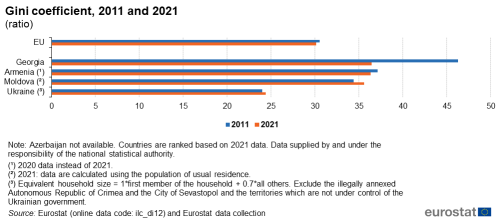
(ratio)
Source: Eurostat (ilc_di12) and Eurostat data collection
Monetary poverty
The poverty threshold shown in Table 1 is set at 60 % of the national median equivalised disposable income (after social transfers). The total net income of each household is calculated by adding together the income received by all the members of the household from all sources. For each person, the equivalised total net income is calculated as the household’s total net income divided by the equivalised household size. This is generally based on the modified OECD scale: a weight of 1.0 for the first adult, 0.5 for other persons aged 14 or over who are living in the household, and 0.3 for each child aged less than 14. Note that some ENP-East countries use different scales for calculating the equivalised household size. The poverty threshold is shown as a monthly income for 2021, ranging among the ENP-East countries from the equivalent of €52 in Georgia (based on consumption rather than income) to €115 in Moldova. The threshold was equivalent to €75 in Armenia (2020 data), €102 in Azerbaijan and €111 in Ukraine.
The at-risk-of-poverty rate is the proportion of the population with an equivalised disposable income below the at-risk-of-poverty threshold. This indicator can be calculated both before and after social transfers; the difference between the two reflects the proportion of the population moved above the threshold as a result of receiving social transfers. Social transfers comprise benefits such as old-age and survivors’ (typically widows’ and widowers’) pensions; unemployment, family-related, sickness and invalidity, education-related and other benefits; housing allowances; and social assistance.
As the poverty threshold is set independently for each country, the at-risk-of-poverty indicators reflect low incomes in comparison with other residents of the same country. This does not necessarily imply an absolute low standard of living for all those below the threshold. 2021 data concerning the at-risk-of-poverty rate before transfers are only available for Moldova at 27.6 %, considerably below that of the EU at 45.3 %.
Among the ENP-East countries for which data on the at-risk-of-poverty rate after social transfers is available for 2021, the highest rate was observed in Armenia at 27.0 % (2020 data), followed by Ukraine at 23.4 %; Moldova, at 22.6 %; and Georgia, at 18.9 %. The at-risk-of-poverty rate was lower in the EU at 16.8 %.
In 2020 in Armenia the at-risk-of-poverty rate after social transfers was 1.6 percentage points lower for women than for men. In Georgia in 2021, the rate was 0.7 percentage points lower for women. The at-risk-of-poverty rate after social transfers was 2.2 percentage points higher for women than for men in Moldova in 2021. Data disaggregated by sex is not available for Ukraine. In the EU, the proportion of at-risk-of-poverty rate after social transfers for women was 1.4 percentage points higher than for men in 2021.
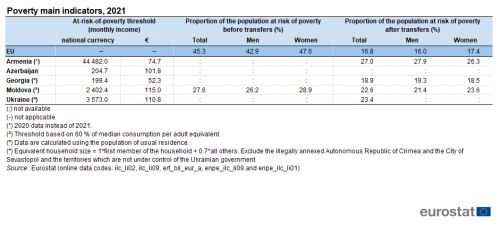
Source: Eurostat (ilc_li02), (ilc_li09), (ert_bil_eur_a), (enpe_ilc_li01) and (enpe_ilc_li09)
With the exception of Moldova, in all of the ENP-East countries for which data are shown in Figure 3, the proportion of the population at risk of poverty after transfers fell between 2011 and 2021 (or the latest year for which data is available). The greatest decrease was observed in Armenia (2020 data) at -8.0 percentage points (pp)), followed by Georgia at -4.1 pp and Ukraine at -0.9 pp. The proportion of the population at risk of poverty after transfers in Moldova increased by 2.4 pp over this period, although there is a change in the data series. Data are not available for Azerbaijan. The percentage of the EU population at risk of poverty after transfers was estimated to have marginally fallen by -0.1 pp between 2011 (estimated) and 2021.
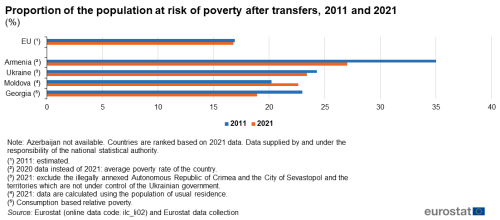
(%)
Source: Eurostat (ilc_li02) and Eurostat data collection
Social protection expenditure
Social protection expenditure comprises social protection benefits, administration costs and other expenditure. The data shown in Figure 4 and Table 2 generally only cover benefits, although administrative costs are included for Georgia. Social benefits consist of transfers, either in cash or in kind, that are provided by social protection schemes to households and individuals in order to relieve them of the burden of a defined set of risks or needs, on the basis that there is neither a simultaneous reciprocal nor an individual arrangement involved. The list of risks or needs is defined as: sickness/health care; disability; old-age; survivors (widows, widowers, orphans, etc.); family/children; unemployment; housing; and other social exclusion. Note that not all health expenditure falls within social protection expenditure.
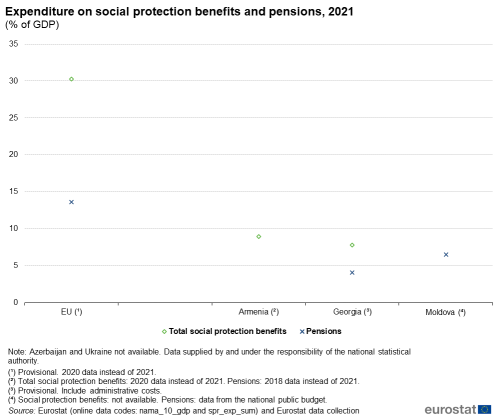
(% of GDP)
Source: Eurostat (nama_10_gdp) and (spr_exp_sum) and Eurostat data collection
Figure 4 illustrates expenditure on both social protection benefits as a whole and on pensions as a percentage of GDP in 2021 or in the latest year for which data is available. Table 2 compares this data with the situation in 2011.
Total expenditure on social protection benefits as a percentage of GDP increased in Georgia from 6.1 % in 2011 to 7.8 % in 2021 (provisional data). In Armenia, expenditure on social protection benefits was 8.5 % of GDP in 2011 and 9.0 % of GDP in 2020. Total expenditure on social protection benefits in the EU was equivalent to 27.0 % of GDP in 2011 and 30.3 % (provisional data) in 2020.
Expenditure on pensions accounted for under half of the total expenditure on benefits in the EU in both 2011 and 2020. In Armenia, pensions represented 80 % of total expenditure on social protection benefits in 2011. In Ukraine in 2011 the share of pensions in total expenditure on social protection benefits was 51 %. In Georgia, provisional data give the share of pensions in social protection expenditure of 53 % in 2021, the same value as in 2011.
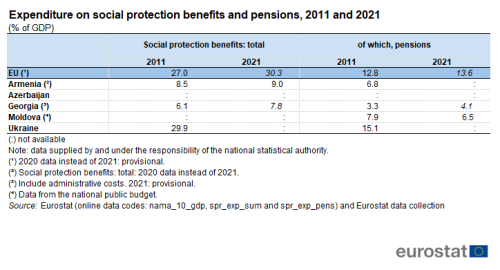
(% of GDP)
Source: Eurostat (nama_10_gdp), (spr_exp_sum) and (spr_exp_pens) and Eurostat data collection
Source data for tables and graphs
Data sources
The data for ENP-East countries are supplied by and under the responsibility of the national statistical authorities of each country on a voluntary basis. The data result from an annual data collection cycle that has been established by Eurostat. These statistics are available free of charge on Eurostat’s website, together with a range of additional indicators for ENP-East countries covering most socio-economic topics.
EU statistics on income and living conditions (EU-SILC) is an instrument that aims to collect timely and comparable data on income, poverty, social inclusion and living conditions, in both monetary and non-monetary terms. The data are generally collected for private households and household members. EU-SILC provides both cross-sectional data and longitudinal data, typically over a four-year period. The legal basis for this data collection exercise is Regulation (EU) 2019/1700 of the European Parliament and of the Council of 10 October 2019 establishing a common framework for European statistics relating to persons and households, based on data at individual level collected from samples. It is supported by a series of implementing regulations and special data collection modules that relate to the collection of secondary variables on a less regular basis. Eurostat’s website provides an overview of legislation related to EU-SILC.
The European system of integrated social protection statistics (ESSPROS) is a common framework developed within the European statistical system (ESS) that has been designed to provide a coherent comparison across European countries (the 27 EU Member States plus Iceland, Norway, Switzerland, Serbia and Turkey) of social benefits to households and their financing, in terms of precisely defined risks or needs that refer to the ESSPROS functions: disability, sickness/health care, old-age, survivors, family/children, unemployment, housing and social exclusion. The legal basis for the data collection exercise is provided by Regulation (EC) No 458/2007 of the European Parliament and of the Council on the European system of integrated social protection statistics (ESSPROS). ESSPROS is composed of a core system that contains annual data from 1990 onwards on (gross) expenditures and receipts. In addition to the core system, one module on pension beneficiaries and one on net social benefits data are available.
Tables in this article use the following notation:
| Value in italics | data value is forecast, provisional or estimated and is therefore likely to change; |
| : | not available, confidential or unreliable value; |
| – | not applicable. |
Context
Social protection systems are generally well-developed in the EU: they are designed to support people to some degree facing the risks and needs associated with unemployment, parental responsibilities, sickness/health care and invalidity/disability, the loss of a spouse or parent, old-age, housing and other forms of social exclusion.
The policy framework for social protection and social inclusion aims to reduce poverty and social exclusion, increase employment and address the specific situation of young people. The social investment policy measures aim to address Europe’s current challenges:
- Economic crisis – unemployment and poverty and social exclusion levels have reached record highs. They are a huge drain on Europe's human resources at a time when public budgets are under pressure.
- Demographic changes – the working-age population in Europe is shrinking, while the proportion of older people is growing. Solutions must be found to ensure sustainable and adequate social protection systems.
The European Commission’s European Social Fund Plus (ESF+) 2021-2027 contributes to the EU’s employment, social, education and skills policies, including structural reforms to tackle the socio-economic crisis caused by the COVID-19 pandemic. The ESF+ will support the EU’s green, digital and resilient recovery from the crisis by driving investment in jobs, skills and services. The ESF+ will also promote the horizontal principles of gender equality, respect for fundamental rights, equal opportunities and non-discrimination. ESF+ funding will focus on:
- Social inclusion
- Education and skills
- Employment
These measures to develop Member States’ social protection systems work through the open method of coordination (OMC), an inter-governmental voluntary process used to support common objectives through cooperation, peer reviews and Commission surveillance.
On 2 July 2021, the European Commission and the EU High Representative for Foreign Affairs and Security Policy presented the Eastern Partnership: a Renewed Agenda for cooperation with the EU’s Eastern partners. This agenda is based on the five long-term objectives, with resilience at its core, as defined for the future of the Eastern Partnership in the Joint Communication Eastern Partnership policy beyond 2020: Reinforcing Resilience – an Eastern Partnership that delivers for all in March 2020. It is further elaborated in the Joint Staff Working Document Recovery, resilience and reform: post 2020 Eastern Partnership priorities. It will be underpinned by an Economic and Investment plan. The Joint Declaration of the Eastern Partnership Summit ‘Recovery, Resilience and Reform’ of 15 December 2021 reaffirms strong commitment to a strategic, ambitious and forward-looking Eastern Partnership.
In cooperation with its ENP partners, Eurostat has the responsibility ‘to promote and implement the use of European and internationally recognised standards and methodology for the production of statistics, necessary for developing and monitoring policy achievements in all policy areas’. Eurostat undertakes the task of coordinating EU efforts to increase the statistical capacity of the ENP countries. Additional information on the policy context of the ENP is provided here.
Direct access to
- All articles on non-EU countries
- European Neighbourhood Policy countries — statistical overview — online publication
- Statistical cooperation — online publication
- Living conditions – overview over all articles on living conditions
- EU statistics on income and living conditions (EU-SILC) methodology - online publication
Books
Factsheets
Leaflets
- Basic figures on the European Neighbourhood Policy — East countries — 2020 edition
- Basic figures on the European Neighbourhood Policy — East countries — 2019 edition
- Basic figures on the European Neighbourhood Policy — East countries — 2018 edition
- Basic figures on the European Neighbourhood Policy — East countries — 2016 edition
- Basic figures on the European Neighbourhood Policy — East countries — 2015 edition
- Basic figures on the European Neighbourhood Policy — East countries — 2014 edition
- International trade for the European Neighbourhood Policy — East countries — 2016 edition
- European Neighbourhood Policy-East countries — Statistics on living conditions — 2015 edition
- European Neighbourhood Policy — East countries — Key economic statistics — 2014 edition
- European Neighbourhood Policy — East countries — Labour market statistics — 2014 edition
- European Neighbourhood Policy — East countries — Youth statistics — 2014 edition
- Population and social conditions (enpe_pop)
- Living conditions (enpe_livcon)
- Income distribution (enpe_incom)
- Relative poverty (enpe_pov)
- Social and health expenditure (enpe_sh_exp)
- Living conditions (enpe_livcon)
- People at risk of poverty or social exclusion (Europe 2020 strategy) (ilc_pe)
- Income distribution and monetary poverty (ilc_ip)
- Living conditions (ilc_lv)
- Social protection (spr), see:
- Social protection expenditure (spr_expend)
- Eastern European Neighbourhood Policy countries (ENP-East) (ESMS metadata file — enpe_esms)
- Income and living conditions (ESMS metadata file — ilc)
- Social protection (ESMS metadata file — spr)
- European External Action Service — European Neighbourhood Policy
- Joint Communication JOIN(2020) 7 final: Eastern Partnership policy beyond 2020: Reinforcing Resilience - an Eastern Partnership that delivers for all (18 March 2020)
- Joint Staff Working Document SWD(2021) 186 final: Recovery, resilience and reform: post 2020 Eastern Partnership priorities (2 July 2021)
- Joint Declaration of the Eastern Partnership Summit: ‘Recovery, Resilience and Reform’ (15 December 2021)
- Directorate-General for Employment, Social Affairs and Inclusion
- Directorate-General for Employment, Social Affairs and Inclusion — Social protection and social inclusion
- European Commission — Europe 2020